To help you overcome the often difficult fishing conditions in the final month of winter, I’ve compiled a list of my top-performing grayling flies for February.
February is a changeable month, especially when the weather shifts from southwest to northeast. For example, I’ve experienced temperatures in February from below ZERO (-10°C) to a pleasant 14°C.
I have learned the hard way to avoid fishing the Welsh Dee when the temperature is forecast to stay below freezing. It’s not fun spending most of the day…
de-icing your rod rings and your body parts!
Fortunately, sub-zero temperatures are rare, and the long-term historical average temperatures for Llangollen in February are a daytime high of 8oC and a night-time low of 3oC.
Fly hatches (Large Dark Olives) are often sparse on the Welsh Dee during February and are limited to the warmest time of the day, usually between 12 and 2 pm. Other than that, grayling will be searching the riverbed for food: nymphs, larvae, worms, etc.
So, how does all of the above affect my…
Go-To Grayling Flies for February?
After reviewing the data in my grayling fishing log, the primary selection criteria for grayling flies for February were…
Water Clarity & River Level.
Using water clarity and river level, I defined four subgroup conditions to share the flies and fishing approaches that have consistently caught grayling.
Weather conditions do influence the grayling fly selection, and where relevant, will be covered for each sub-group.
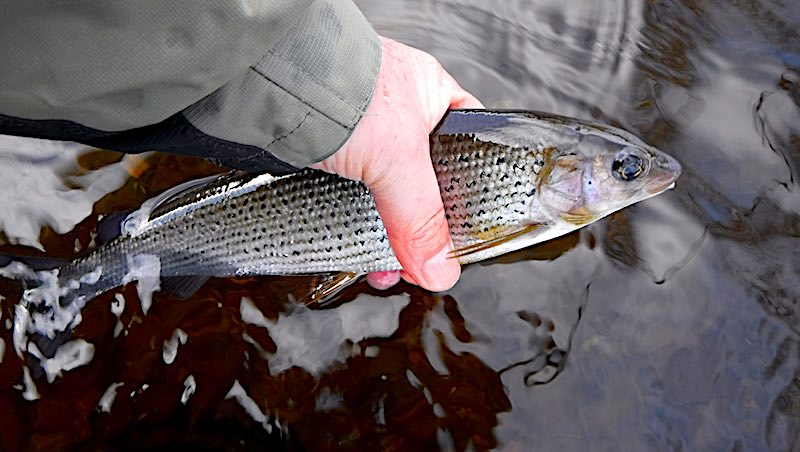
By February on the Welsh Dee, grayling have shoaled into the large pools, which provide shelter when the river is in flood. Therefore, I focus on fishing the following pools at Llangollen:
Grayling flies for February when the river level is below 0.7m
a) Fly choice for clearwater conditions
In the absence of surface fly life, fishing a team of nymphs close to the riverbed is often the best approach because that’s where the grayling will be feeding ( Euro or Czech nymphing).
When the river is running low and clear, fishing the following nymphs spaced 18″ apart on a 4 lb fluorocarbon leader has produced plenty of grayling.
February Nymph selection…
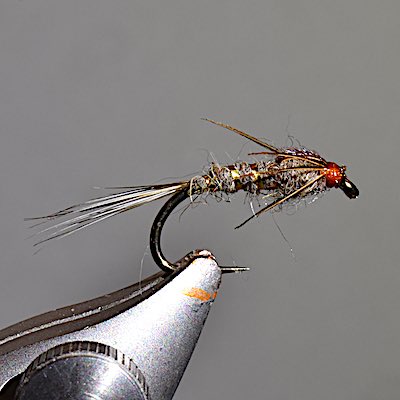
Gold ribbed Hare’s Ear
- Hook: #16 to 12 Kamasan
- Weight: up to 6 turns of lead wire
- Thread: Rusty brown 8/0 Uni-Thread
- Tail: Ginger cock fibres
- Body & Thorax: WAPSI light Hares Mask
- Rib: Gold tinsel
- Thorax cover: 6 pheasant tail fibres

Red Nymph TB
- HENDS BL164 (#16 & #14)
- 2 mm tungsten bead
- Body – red UNI-thread 8/0
- Thorax – Hare’s Ear dubbing
- Thorax Cover – Ice Blue Pearl Tinsel
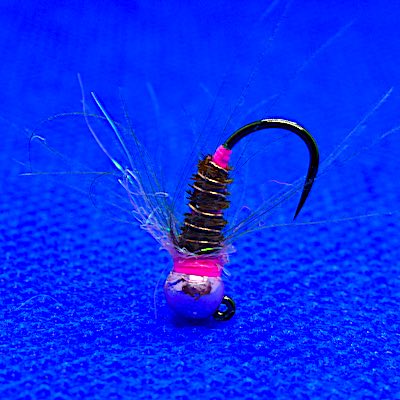
Pink Pheasant Tail Nymph
- Hook: HENDS BL120 (#14 & 12)
- Bead: 3 to 3.5mm pink tungsten
- Thread: pink UNI-Thread 8/0
- Body: pheasant tail fibre
- Rib: fine copper wire
- Hackle: CDC feather
- Collar: Veniard glister sparkle pink dubbing
If the temperature warms as the day progresses, watch out for hatching flies (midges or large dark olives) or rising fish. When either happens, I usually find it best to switch to fishing a team of spiders, wet flies, or dry fly fishing.
Spider / Wet fly selection for February:
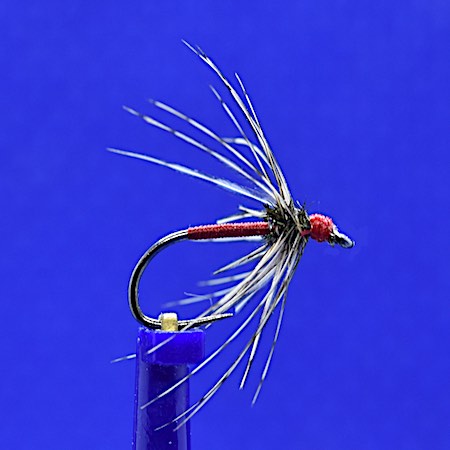
February Red Spider
- HENDS BL164 (#16 & #14)
- Body – red UNI-thread 8/0
- Thorax – 2 turns of peacock hurl
- Grey partridge neck hackle
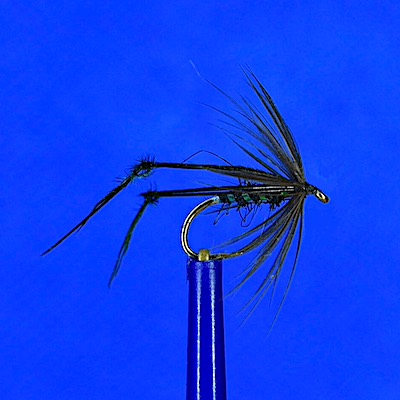
Black Hopper
- Kamasan B170 (size 14)
- Black UNI-thread 8/0
- Rib – Uni Pearl Mylar #14 (1/32)
- Legs – Knotted black pheasant tail
- Black hen hackle
Dry fly selection for February:
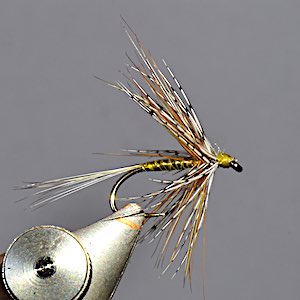
Jingler fly
- Hook: Kamasan B170 #14 & 12
- Thread: Olive 8/0 Uni-Thread
- Tail: Badger cock fibres
- Body: Hends body quill BQ-32
- Rear hackle: Ginger cock
- Front hackle: Grey partridge
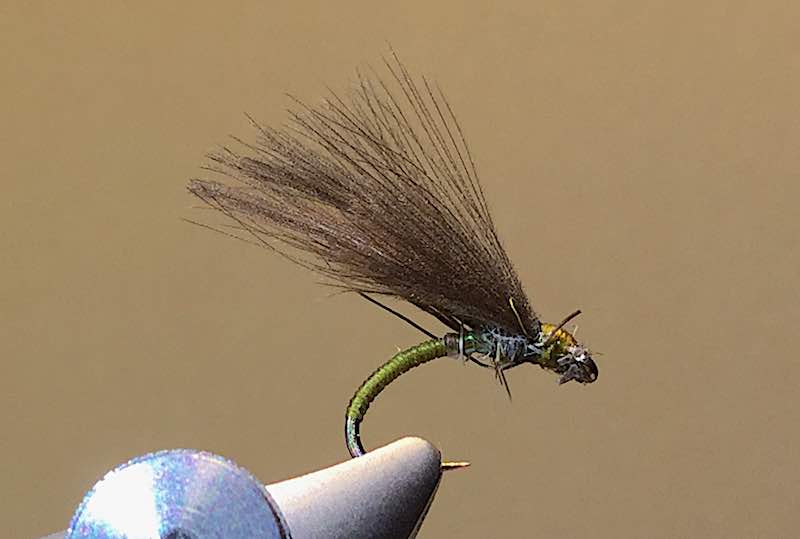
CDC Olive emerger
- Hook: Kamasan B100 #16 & 14
- Thread: Olive UNI-Thread 8/0
- Thorax: Hare’s ear dubbing
- Wing: 3-4 CDC feathers
b) Fly choice for coloured water
Even after a small spate, the Welsh Dee will quickly colour when the River Alwen floods. Once water clarity drops below 3ft, fishing brightly coloured nymphs close to the riverbed is, by far, the best approach for catching Welsh Dee grayling.
Two successful nymphs for coloured water that make it into my grayling flies for February list are:
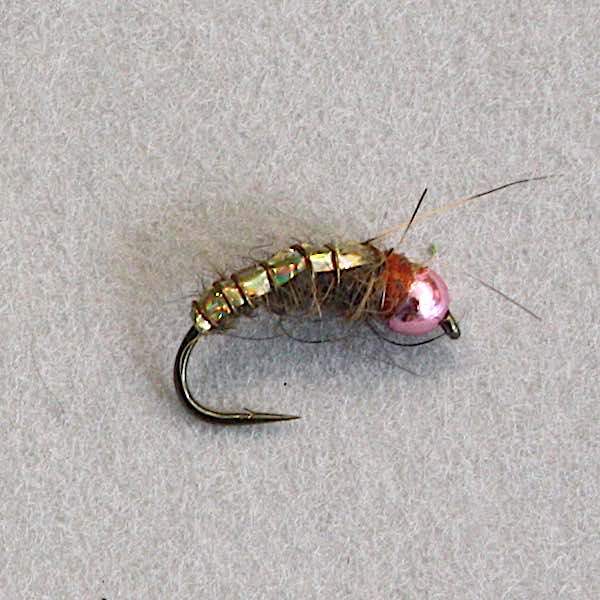
Hare’s Ear – gold shellback
- Kamasan KB110 (size 14)
- 2.5mm pink or gold tungsten
- Brown UNI-thread 8/0
- Body – Hare’s ear dubbing
- Rib – fine gold wire
- Back – flat gold tinsel (2mm)
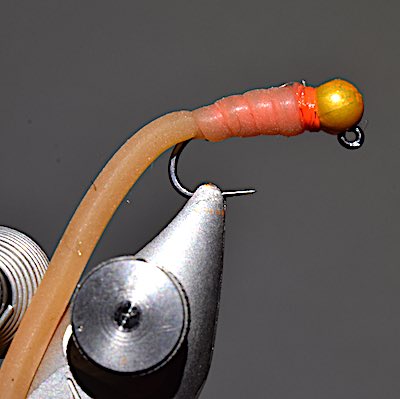
Orange Squirmy Worm
- HENDS BL120 (size 12)
- 3.5mm metallic orange tungsten bead
- Orange UNI-thread 6/0
- Body/tail – Veniard earthworm body
Flies for February when the river level is above 0.7m
After a prolonged wet spell, it can take weeks for the Welsh Dee to fall towards its summer level. Under such conditions, the water can be running clear even at levels above 1m (Manley Hall gauge).
a) Clearwater grayling fly choice
It’s still possible to catch grayling using dry flies, wet flies, and spiders. However, nymphing is often a more productive approach.
In high water, it’s best to use a heavy jig nymph on the point fly to drag the smaller flies on the middle and top droppers into the feeding zone.

Olive Tungsten Jig-back
- Hook: HENDS BL120 #12 & 10
- Weight: Tungsten jig-back
- Thread: Dark Brown UNI-Thread 8/0
- Tail: Badger cock fibres
- Tag: GLO-BRITE Fluorescent orange
- Body: Olive synthetic quill
Often, I team the small nymphs covered in section (a) with the heavy point nymph.
b) Grayling fly selection for high, coloured water
When the river is flowing high and coloured, grayling often lie in slack water either on the inside bends of the pools, behind obstacles, or back eddies. Under such conditions, fishing a heavy squirmy worm on the dropper above a jig point fly is often the best approach.
The following photographs of Duncan’s Pool were taken when the river level was 1 m (Manley Hall gauge).
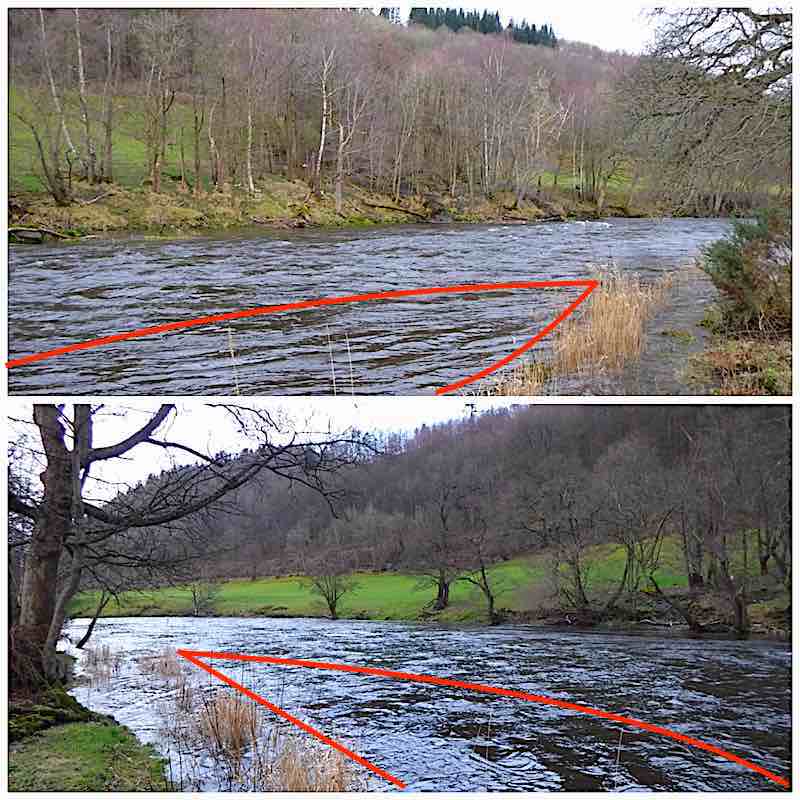
The zone outlined by the red lines is where I catch most grayling in Duncans when the river is in flood. The rest of the pool is virtually unfishable because the river is flowing too quickly.
Grayling flies for February summary:
To summarise my grayling fly recommendation for different river conditions I have produced the following selection matrix:
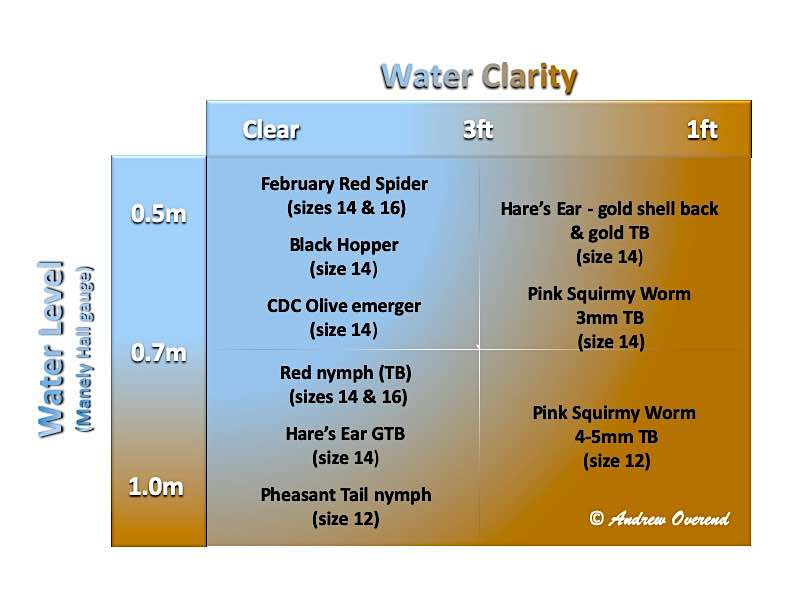
The above advice is based on flies that have reliably caught grayling. Therefore, it’s a great starting point for newcomers to the Welsh Dee. Also, it may help more seasoned anglers.
For more on grayling fly fishing in February, you will find the following post interesting:
- Winter fly fishing for grayling: Great tips for beginners
- Fishing the River Derwent for beautiful ladies
If you are interested in grayling fishing there is some excellent Day Ticket Water on the Welsh Dee.
I hope you find this post useful and it would be great to hear about your favourite grayling flies for February in the comments below.

With all the above info, it’s a shame l can’t use it this year. Hope l can remember it all for next year, fingers crossed.
Excellent
Cheers, Andrew
Hi Steve,
It is a big shame that it can’t be put into practice this year. However, the information will still be on my website and I look at updating it again and repost next Feb. So all is not lost.
Cheers and thanks for the comments, Andrew
Pretty much covers all conditions in February with that article Andrew , do you buy into the disturbing the bottom as you wade when deep nymphimg does it release larvae etc to downstream fish get them turned on to feeding ?
Hi James,
I try not to disturb the riverbed when fishing for grayling on the Welsh Dee because salmon spawn in the river and I don’t want to accidentally disturb their redds.
Thanks for the feedback, Andrew
brilliant piece again very nice well done
Hi Colin,
Thanks for the feedback and I’m glad you enjoyed the article.
Cheers, Andrew
Another excellent article Andrew. Just wish for a half decent day to get out.
Hi Brian,
Glad you enjoyed the post. I hope you manage to get out fishing. If you do, it would be great to know how you get on.
Cheers, Andrew
A useful read as usual! One method of stopping the line freezing to the rod rings is to apply Vaseline to the eyes. Obviously wiping the line off at some warmer stage.
Hi Bryan,
Thanks for the tip for stopping the line from freezing in the rings.
Cheers, Andrew
Hi Andrew.
Enjoyed the post.
I hope to get onto the Ribble in the next couple of weeks.
Hi Ian,
Great to hear you enjoyed the post and good luck on the Ribble.
Andrew
Fab info as usual, going to try similar methods now on local waters
Thanks for the feedback. Cheers, Andrew
February Grayling on the Dee is very interesting and will adapt well to the Eden , the articles arereallly well put together and photo quality is excellent, much appreciated.
Hi Phil,
Great to hear you enjoyed the post. Would be great to know how you get on fishing the flies on the Eden.
Tight lines, Andrew
BRILLIANT INFO.
Hi David,
Thanks for the feedback.
Cheers, Andrew
Makes good reading Andrew.
Very helpful Andrew, especially the advice for high water conditions as the Goyt and Mersey seem to be either too high or too low these days.
PS it’sa shame your talk to the grayling society isn’t going to be on Zoom, I would have liked to see it. Next time perhaps?
Hi Donald,
Great to hear it was helpful and I hope it helps you catch more fish on your local rivers, neither of which I’ve had a chance to fish.
I will let you know if I’m invited to give the talk again.
Tight lines, Andrew
Always good to read your articles and the in-depth manner of the flies but did you not do something very similar before. Tight lines. Iain Fraser.
Hi Iain,
I’ve done a fly selection for each month of the year and there is some overlap of what seems to work best over winter.
Andrew
Excellent article as usual Andrew. All the very best for the New Year and tight lines.
Hi Scott,
Great to hear you enjoyed it and tight line for this year, Andrew
Cheers Andrew